Near the improbably named Botany Bay in the North York Moors threads Ouse Gill beck, plunging swift and strong through ironstone and shale deep down into the cut of Bransdale. Travel into the heart of the dale and you will find the National Trust’s High Lidmoor farmhouse, rented to holiday-makers like us: people on the hunt for adventure in the wildlands of the National Park; for escape from the humdrum everyday; for what Richard Mabey calls the ‘nature cure’. ‘Botany Bay’ conjures Antipodean daydreams, making its appellation here bizarre in the extreme, the village sitting in the middle of the North York Moors, where the briskly cold moorland tops brim with heather, offering a kind of wilderness irrevocably removed from the hot sand of south-of-the-equator beaches.
With music humming from the car speakers, we make our winding way through Gillamoor and begin to climb the moor. Twice we make a wrong turn just beyond Ouse Gill Beck and, my navigation skills cast into disrepute, I am relegated (perhaps fairly) to passenger only. But another thought occurs to me, legacy of countless children’s books where entrance portals to other worlds are found only after a test has been passed: the holiday destination that is hard-won is at once more worth the trouble, more private, and more likely to lead to adventures. This is a good sign, I think to myself, in this way neatly excusing my poor navigational skills. In direct proportion to the increasingly wild beauty of the landscape, dwellings of the human variety become fewer; instead gluts of beehives colonise the purpling moor-tops with their sweet promise. The bees are in heaven — in heather — up here under a sky I am not used to thinking of as so silvery-big. It hangs with infinite possibility. Scuds of cloud are caught on it, their pace leisurely and unhurried — a pace it is only natural that I will borrow for the week.
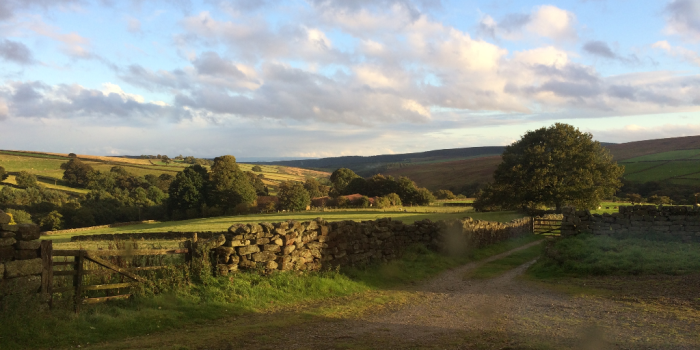
We climb the moor road which ridges the valley like a spine and startle unwary cock pheasants into berserk runs. Others pay us no mind at all and dawdle regally as if to make a point of access rights. Good for you, I think, as we go up and over the moor. It feels wonderfully remote up here, as though we are putting the rest of the world away for the week, and I can already feel myself ready to slough off my working day self: all the minutiae of life that keep us small and wearied in a busy world. A left turn with caution down the valley (the car managing the traps in the road woozily, jostling us back and forth), and then the breath held as we arrive up the gated farm track to take stock of our new fiefdom. Clouds spool out over the sky, farms pocket the fells on either side and between them fall enclosed plots laid out untidily like a quilter’s fat quarters, drystone walls threading between them. A great sycamore tree alongside the track pins the focus of the view to itself. Everything, for a week at least, is ours to the horizon line, and I am temporary custodian of this house and land.

High Lidmoor is a stone-built eighteenth-century farmhouse full of all the homely character we could wish for in a week away, and we fall into the swift game of choosing bedrooms and putting our possessions away the better to claim it as ours. I don’t think it would judge us if we spent the whole week indoors reading (my bag is bulging with books), baking and just being. Yet it’s a practical house too with its porch for walkers’ gear. Settling down in the easy chair in the living room with my book, I am facing two windows onto the little banking rise at the back of the house which leads up to the moor. Surprisingly close, the woolly white fleece of a grazing sheep passes outside, and in another minute a few more of them potter past nonchalantly mowing the grass. Then my eye focuses on the brown patches in between and I realise that there are countless rabbits among the sheep, fellow grazers enjoying an afternoon feast; little balls of brown fur almost invisible to a merely human gaze, were it not for the typewriter motion of their heads along the grass. The windows frame them like an alternative and better TV and, my book forgotten, I’m hooked.
It is the beginning of a steadfast fascination over the course of the week’s stay and – though I felt it when we first entered the comparatively small Bransdale – I begin to appreciate that this is indeed a special place, with the suggestion of being the last fully-wilded bastion in Britain. A townie by birth, I have never before seen so much wildlife so plentifully and trustingly out in the open. With the present day list of endangered species growing and the drive to conserve and ‘reserve’ natural habitats, it is refreshing to experience wildlife so blithely careless of my own human intrusion into its domain. I stand at the window for some time and watch a rabbit clean itself, totally absorbed by its fidgety and particular movements: the ears relaxed and mobile in the absence of any perceived danger; the hind leg up to scratch; the twitching of its mouth. It has not escaped me that glass divides us and I know very well that were I to venture outside into the rabbit’s world it would freeze, turn its impossibly snowy white tail (how do rabbits’ tails stay so clean?), and run. Meadow pipits arrive like leaves blown in haphazardly on the wind to their over-wintering homes, picking over the ground between their larger neighbours of grouse, partridge and pheasant.
I go out the first clear night to see the stars shining brightly, pricked into the deep blue velvet of the sky, for once uneclipsed by the cityscape smudges I am used to. Bats sound overhead with their leathery flights and I stay out a while to spot constellations, occasionally obscured by black shadows passing between me and the stars, quick as an eye blink. Leaving my curtain ajar at night, I wake with the sunrise to a new morning ritual of looking out to see what is stirring in the spell of mist that rests in the valley with the fragile impermanence of spider silk. Only the lonely sycamore punctuates it. Seeming to hover over the lane, the tree is a ghost of its yesterday self. I feel as though I could blow a puff of wind down the dale and send all the mist scattering into nothing. High Lidmoor is a place which seems to invite such fancies.

On an impulse, I want to awaken the valley out of its shroud; to stir it up; and put the dozy pheasants picking prettily like dainty pedants along the lane to flight. They’ve got the world to themselves at this hour, safe from intrusions upon their morning perambulations. With mayoral swagger, wearing their feathers with vanity as badges of office, they are curve-bellied, sleek and ponderous. Mischief takes over and before I know it I am impatiently booted and out the door onto the hard core of limestone and shingle. The pheasants have heard me coming and scramble in their undignified runs down the lane, bobbing under the fence with outraged croaks. It seems they will only fly at great need, preferring to wheel their legs like pull-along toys, but always with the perfect posture of their office. I have a fast-growing affection for them: the glib walk, the tail feather dashing and signing the air in their wake, the green neck and white collar – some of the best plumage that fowl finery has to offer.
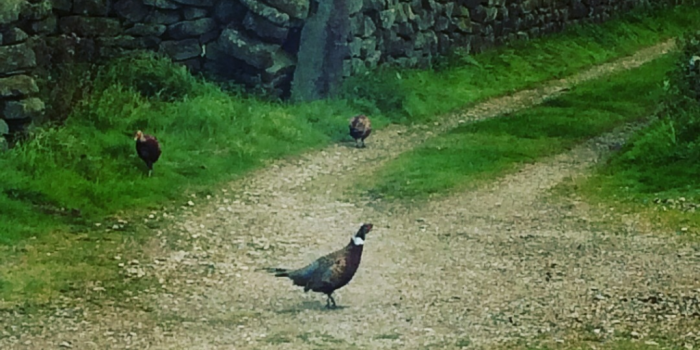

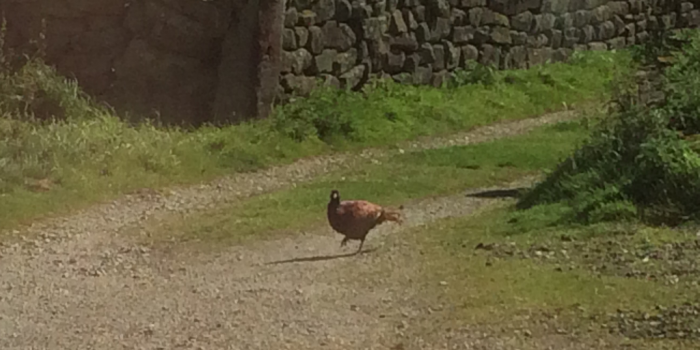
Walking out on the tops of the moors I am at the ‘betweening’ of the seasons: summer is issuing bursts of sunshine and warmth, and autumn is beginning to claim the heather, scorching the tops of the fells with its slow, amorous burn. The arrival of the meadow pipits signals cooler autumn weather on the way, but it is still warm enough to leave my coat behind. I hug the dry stone walls (stone is the Yorkshire building element) as I ascend the hill behind the house, passing a fir plantation to my left and a view unravels before me in broad strokes of greens, purples and golds under the vast open sky. The weather changes quickly here but I have some warning: I see the rain coming up the valley and try to judge the time it will take to reach me as the grey stretches out its fingers up the hillside. I search out cover in the wide open space and hunker down into a rabbit run between deep marram grasses. It is boggy, cold and wet, and I instantly question the wisdom of this hiding place. Better to be on, to spring the fence and climb into the other fir plantation down by the pond. The dense needles of a spruce enwomb me and I am an escaped Magwitch under a desultory tree, under the clouds, under the rain. It is a humorous position in which I find myself, mingling with spiders, scarlet cap fungi, and last year’s pine needles underfoot. I am almost supine in my idiocy without my coat. But it is a close vantage point which allows me to observe the particularities of things.
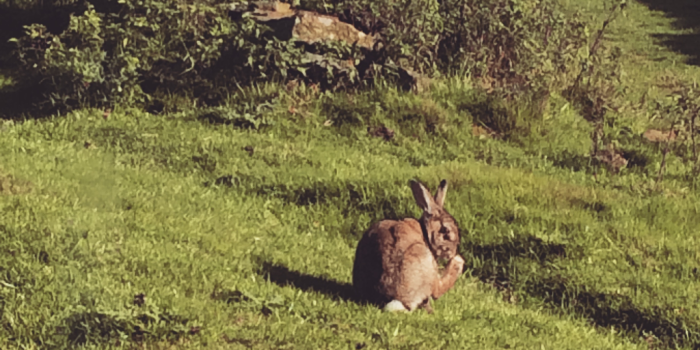
Silflay for the rabbits lasts all day and there is one abiding pattern: feed, flight, hide. They are particular creatures, industrious little mowers grazing the thin grass of the fields, round little balls focussed downward. Their sidewise eyes are alert to danger in case of encroachers – least patient of strangers of all the wildlife I have encountered here. I can be 200 yards distant and my steps will render them absent. I am the flight-provoker; the scurry-hurrier; the threat-deliverer. Yet even in flight rabbits are interesting to study: their run a stretch-gather movement powered by the hind legs. First the ears twitch, noting my presence and alert for the danger I might pose and a stillness settles over them. It’s a stalemate and if I break it, that’s it, they’re off, flowing through the cracks of a dry stone wall with fluidity and economy of energy. Through improbable gaps barely a spit wide – how do they do that? During another holiday in Low Embleton, Northumberland in 1993, a rabbit became my first encounter with death. I was eight years old, and a bother in the wake of an older sister gone for a walk over the sandy hillocks on the extreme edge of the village. I had followed her and she’d probably rather not have had me slowing her down over the duney marshes. I can’t exactly remember now how we came upon the rabbit, only that across the sandy ground we sensed its distress and knew with the clarity that children sometimes have, something was badly wrong about the eyes and the limp-driven limbs. A man and his wife came along, assessed the situation with pinched frowns, and all of a sudden I was clutched tightly to a stranger’s chest and then – whack! – the rabbit was no more. A swift compassion. Soft shock, the thump of rock through bone. Something alive was no more. This was the first I knew of death in the wild and the first I knew of death as a kindness. I was shaken and a little numb as I recounted what had happened to mum back at our week’s home. Myxomatosis she said, a big word for an eight year old to swallow. It came to the UK in the 1950s shortly after it was trialled as a ‘pest’ control in Australia. 99% of our native population of rabbits died in a few years, but numbers have since recovered. Looking about me now, I believe it. Rabbits have the moors almost to themselves up here, more numerous than the game birds. I will always be grateful for the kindness of the stranger who held me tight to her so I wouldn’t see her husband lift and lower the rock in his hand.
It is the curious loneliness that afflicts the nature-lover the most: that which we wish to cherish and be near, we cause to disappear. It is a shame and I regret it: to approach the natural world with wonder and joy and yet feel myself to be excluded – by virtue of humanness – from it. But it is the curse of our over-industrialized, intensively-farmed age. We love the wild, yet at best our presence constantly transforms it and, at worse, destroys it. These are the melancholy thoughts that plague me in this kind of lonely, nature-retreating funk. I can watch the wildlife and wonder at it, but I will never be wilded into it. I am in a world of vital bodies, could I but see them, yet I feel myself to be utterly alone up here, on the crown of the fell, on the cusp of the world.

Perhaps it’s the slower pace of things, or the delicious-tasting water piped in from a nearby spring, or the sheer availability of so much wildlife to watch at close quarters, but gradually over the course of the week the tensions of elsewhere ease and I am delightfully weathered into the rhythms of the cottage, birds, sheep and rabbits outside its windows. Waking with, watching and following the wildlife outdoors becomes my routine and my obsession. Swallows stoop and swerve outside my window one morning, swooping through the air in swinging motions to catch insects ready for their migratory journeys to Africa. Strange to think of such a staple of the countryside soon to be flying over sub-Saharan dust. Their destination on each scoop-dive is the eaves outside my window, a muster line on the edge of the roof. No telegraph wires here for them to settle on as they prepare for their great journey. The risks are high, some will not return. With the changing seasons, all creatures are having to adapt – the swallows now arrive a week earlier each year than they did in the 1970s, and I wonder if in fact they tarry later as well, putting off the inevitable, as I do before the commute to work?
Like the swallows, I will return here, and slip once again into the rhythms of Bransdale.
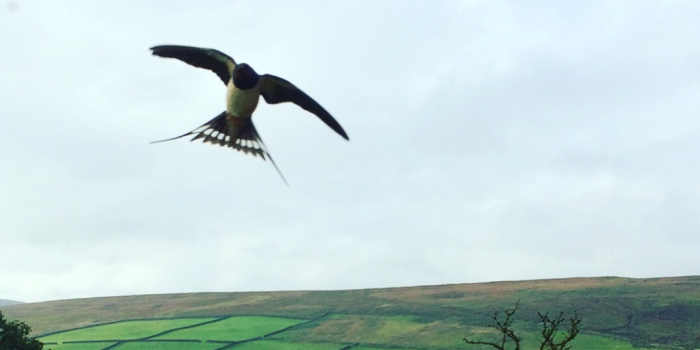
Thank you for sharing your walk. It sounds like a beautiful place, not an area I’ve visited.
LikeLike
Thank you. It is lovely up there – the largest continuous moorland in the UK.
LikeLiked by 1 person
A very well chosen holiday location, beautifully and sensitively described. I hope you will return there and report back again. What a wonderful world waits for us outside our windows!
LikeLiked by 1 person
I found it to be such a tantalising view and such a special place Richard! I was with family and it was so lovely just to have a space in which simply to exist was enough for a week. Thank you, as always, for your kind words 😊
LikeLike
Absolutely gorgeous Kylie, this reminds me of my holiday in Northumberland last year with the wide open skies and the hordes of rabbits dotting the fields. Your take on navigation also made me laugh as I have also been known to justify getting lost with the trials of an adventurous pilgrimage! So much beautiful imagery here – the swagger of the pheasants, the ‘betweening’ of the seasons, the escaped Magwitch – and I adored your description of the sycamore and the morning mist.
LikeLiked by 1 person
Thank you! I was bowled over by the sheer volume of wildlife I wouldn’t ordinarily see at High Lidmoor. Such an amazing place! I’ll definitely be back I think 😊
LikeLiked by 1 person
I already looked it up, unfortunately they don’t let dogs go!
LikeLike
Nice. Beautiful photography too
LikeLiked by 1 person
Thank you 😊
LikeLike